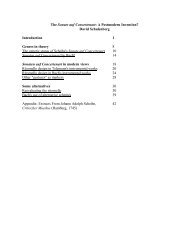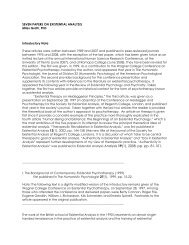download
download
download
You also want an ePaper? Increase the reach of your titles
YUMPU automatically turns print PDFs into web optimized ePapers that Google loves.
W. 4: Sources, p. 20<br />
53<br />
work). His copies, although neat, are not particularly accurate. But they do often give very early<br />
versions, as does A1, which also contains significantly fewer errors than A2 and A3. Yet like<br />
them A1 contains unique performance markings that are unlikely to derive from the composer;<br />
these include the bowings mentioned above in the description of the source. Probably in the same<br />
category are the clearly spurious continuo figures added in A1 on the surprising harmonies of<br />
54 ii.46. These figures, although surely not Bach's, confirm that keyboard players might have<br />
added a continuo realization even when performing from a part that generally has a doubling of<br />
the violin parts in place of figures. Nevertheless, A1 is too unreliable to serve as principal source<br />
of the early version. Yet in many cases it gives unique readings for the notes, and the consistency<br />
with which these readings appear in parallel passages makes it likely that they represent Bach's<br />
otherwise unattested early versions; these readings are adopted in the text of the early version.<br />
A peculiarity of group A is that the three complete sources include alternate performance<br />
markings that are unlikely to derive from Bach, although they superficially resemble his tradition,<br />
using ornament signs described in his Versuch. Yet the underlying text of these sources must be<br />
from a time when Bach was not yet using ornaments such as the trilled turn (prallender<br />
Doppelschlag) or three-note slide (“inverted turn”). Although some of the alternate performance<br />
markings merely supplement what is implicit in other sources, as in the addition of slurs to<br />
certain triplet groups, in general they cannot derive from Bach, as they occur with little<br />
consistency from one source to another. Moreover, the frequency and nature of the alternate<br />
markings in A2 makes it at times more an arrangement than than a copy, and its use of certain<br />
55<br />
ornament signs is somewhat more enthusiastic than typical of Bach. Numerous signs for<br />
mordents in A1, where trills or turns are implied by the context, are also contrary to Bach's<br />
56<br />
usage. As valuable as these alternate performance markings might be for study of the reception<br />
and performance history of the work, it is impractical to report them in full, and therefore only a<br />
representative selection is described in the list of variant readings.<br />
Group B (sources giving intermediate readings)<br />
This is a somewhat miscellaneous set of sources, each of which may represent a somewhat<br />
different state of the work. B1 and B2 in their original states appear to have given relatively late<br />
53<br />
Ulirch Leisinger expresses similar views about this copyist in his essay “Zur Geschichte der Bach-<br />
Sammlung der Sing-Akademie zu Berlin” in Enßlin, 526: “Nach bisherigem Kenntnisstand zeichnen sich Possins<br />
Abschriften nicht durch besondere Sorgfalt aus, was ihren Wert—ungeachtet der Frage der jeweiligen<br />
Vorlagen—relativiert.” Peter Wollny, examining various other sources attributed to Possin, concludes that none of<br />
them derive directly from Bach's house copies; see CPEBCW I/8.2, descriptions for sources D 41 and D 46–8 (pp.<br />
180–1).<br />
54<br />
Those are the only figures in A1, with the exception of the nonsensical figures two measures later (see list<br />
of variants for both readings).<br />
55<br />
For example, in ii.17, third beat, a trilled turn on an unaccented sixteenth note follows two instances of<br />
the same complex ornament in the first half of the measure.<br />
56<br />
Possibly the mordent signs in A1 are later additions; some of these signs resemble the letter “t” and in<br />
certain cases are almost indistinguishable from the cross or + indications.















